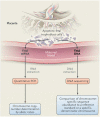Genomics and perinatal care
- PMID: 22216843
- PMCID: PMC4877696
- DOI: 10.1056/NEJMra1105043
Genomics and perinatal care
Figures


References
-
- American College of Obstetricians and Gynecologists Committee on Genetics Committee opinion no. 478: family history as a risk assessment tool. Obstet Gynecol. 2011;117:747–50. - PubMed
-
- Genetic services policy project final report. Washington State Department of Health; Seattle: 2008. ( http://depts.washington.edu/genpol/docs/FinalReport.pdf)
-
- Sharp RR, Goldlust ME, Eng C. Addressing gaps in physician education using personal genomic testing. Genet Med. 2011;13:750–1. - PubMed
-
- de Jong A, Dondorp WJ, Frints SGM, de Die-Smulders CEM, de Wert GMWR. Advances in prenatal screening: the ethical dimension. Nat Rev Genet. 2011;12:657–63. - PubMed
-
- American College of Obstetricians and Gynecologists Committee on Genetics ACOG practice bulletin no. 77: screening for fetal chromosomal abnormalities. Obstet Gynecol. 2007;109:217–27. - PubMed
Publication types
MeSH terms
Grants and funding
LinkOut - more resources
Full Text Sources
Other Literature Sources
Medical
